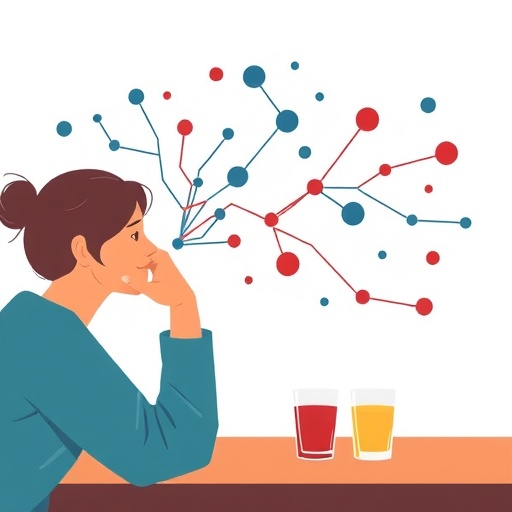In a groundbreaking study published in the International Journal of Mental Health and Addiction, researchers have unveiled complex patterns linking alcohol consumption with anxiety prevalence using a sophisticated statistical approach known as Multiple Correspondence Analysis (MCA). This fresh insight offers a nuanced perspective on the intertwined relationship between alcohol use and mental health, challenging simplistic cause-effect assumptions and opening new pathways for targeted interventions.
Alcohol’s role in mental health has long been a subject of scrutiny, with numerous studies presenting conflicting evidence on whether alcohol use exacerbates anxiety symptoms or serves as a form of self-medication for those already experiencing anxiety disorders. The latest research led by Kolonne, Mudalige, and Dissanayaka et al. sets itself apart by employing MCA, a multivariate analysis technique that allows exploration of complex categorical variables simultaneously, revealing latent associations that traditional methods might overlook.
The investigation analyzed a comprehensive dataset comprising diverse demographic groups, assessing variables such as frequency and quantity of alcohol intake, self-reported anxiety symptoms, and sociodemographic factors including age, gender, and socioeconomic status. By plotting these factors in multidimensional correspondence maps, the team was able to discern clusters of behaviors and symptoms that illustrate the nuanced coexistence of alcohol consumption patterns and anxiety profiles.
One of the most striking findings of the study is the identification of distinct subpopulations wherein moderate to high alcohol consumption correlates with elevated anxiety symptoms, yet these relationships are not linear. In fact, the MCA revealed that some groups experience a form of anxiety reduction associated with light or social drinking, suggesting a complex bidirectional relationship. This nuanced understanding underscores the danger of broad-brush clinical recommendations that fail to address individual variability.
Further technical dissection of the MCA outputs in the study highlights how categorical variables representing anxiety levels and drinking habits converge in latent spaces, revealing overlapping clusters. These clusters elucidate how specific drinking patterns—such as binge drinking versus steady moderate use—map onto anxiety prevalence with varying intensities. Such an analytical breakthrough underscores the utility of MCA in mental health research, providing richer visual and quantitative interpretability compared to regression analyses traditionally used.
The implications of these findings are profound for public health policy and clinical practice. By understanding the subtle gradations in alcohol-anxiety co-occurrence, strategies for mental health intervention can be tailored more precisely. For instance, individuals identified as high-risk drinking subtypes with comorbid anxiety symptoms might benefit more from integrated treatment plans combining behavioral therapy with substance use interventions.
Moreover, the study challenges the stigmatization often attached to individuals with alcohol use disorders by revealing bidirectional and context-dependent associations. Anxiety may not simply result from excessive drinking; in some cases, alcohol consumption patterns might be driven by underlying anxiety disorders, complicating the clinical picture and emphasizing the need for holistic assessment.
From a methodological standpoint, the researchers emphasize the innovative application of MCA to mental health epidemiology. Unlike conventional statistical tools, MCA’s strength lies in its ability to reduce multidimensional categorical data into easily interpretable component maps that facilitate identification of non-obvious relationships. This approach could revolutionize how future research tackles multifactorial mental health problems with inherent categorical complexity.
Notably, the visual representations accompanying the study vividly illustrate the interconnectedness between different anxiety severity levels and varied alcohol consumption behaviors. These visual insights not only enhance scientific communication but also provide a platform for non-specialist stakeholders to grasp the intricacies of the alcohol-anxiety nexus.
The researchers advocate for future longitudinal studies leveraging MCA alongside clinical data to unravel temporal dynamics between alcohol use trajectories and anxiety symptom development. Such efforts could illuminate causal pathways and critical intervention windows, further refining mental health strategies.
Additionally, this research invites reconsideration of screening tools and diagnostic criteria used in clinical practice. Enhanced sensitivity to the heterogeneity in alcohol-anxiety relationships might lead to more personalized diagnostic algorithms capable of distinguishing subtypes that require differentiated therapeutic approaches.
In an era where mental health challenges are escalating globally, the study represents a timely advancement that merges advanced statistical innovation with pressing societal issues. Its findings resonate widely, from clinical psychologists and addiction specialists to public health policymakers seeking evidence-based approaches to mitigate the mental health burdens associated with alcohol use.
The research also raises intriguing questions about cultural and environmental modifiers of the alcohol-anxiety dynamic. As MCA can incorporate multiple categorical factors, expanding the scope to include variables like geographic region, cultural norms, and peer influences could further sharpen understanding of context-specific intervention needs.
Importantly, the study’s methodology underscores the critical value of high-quality, granular data collection in mental health research. The depth of insights achieved by Kolonne and colleagues was enabled by meticulous dataset assembly that captured intricate categorical variables, illuminating the pathways through which alcohol consumption and anxiety intersect.
Finally, the study paves the way for innovative predictive modeling in mental health epidemiology. By integrating MCA-derived clusters into machine learning frameworks, it might be possible to predict individuals’ risk of anxiety following particular drinking behaviors, revolutionizing early intervention and personalized care paradigms.
In conclusion, this pioneering work leverages the power of Multiple Correspondence Analysis to unravel the multifaceted and intricate associations between alcohol consumption and anxiety prevalence. It pushes the boundaries of both methodological application and mental health understanding, promising to inform more nuanced, data-driven strategies that can better address the intertwined epidemics of substance use and anxiety disorders worldwide.
Subject of Research: Associations between alcohol consumption patterns and prevalence of anxiety symptoms using advanced statistical analysis.
Article Title: Investigating the Associations Between Alcohol Consumption and Prevalence of Anxiety Using Multiple Correspondence Analysis.
Article References:
Kolonne, T., Mudalige, K., Dissanayaka, G. et al. Investigating the Associations Between Alcohol Consumption and Prevalence of Anxiety Using Multiple Correspondence Analysis. Int J Ment Health Addiction (2025). https://doi.org/10.1007/s11469-025-01561-8
Image Credits: AI Generated




